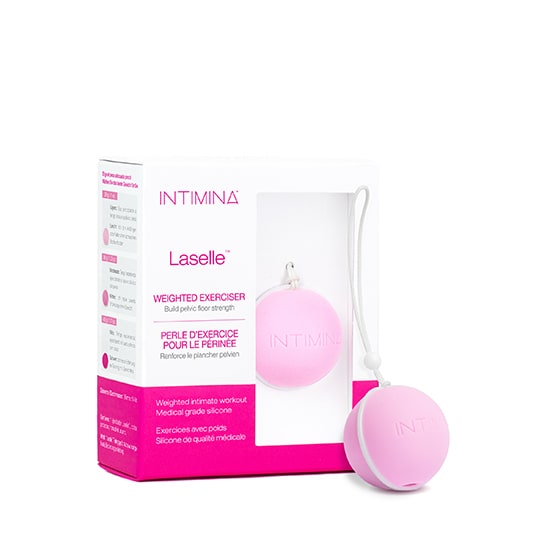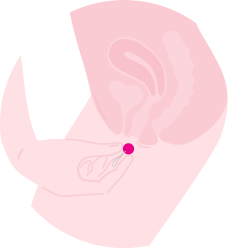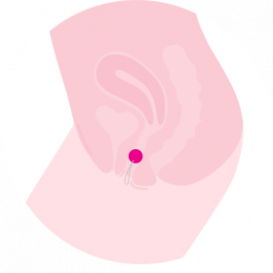How To Use Laselle Pelvic Floor Trainer

Did you know that 1 in 3 women suffer from pelvic floor disorders? All too often women overlook the critical role that their pelvic floor plays throughout the different stages of womanhood. Responsible for bladder and bowel control, a healthy pregnancy, and preservation of vaginal tone, strong pelvic floor muscles are absolutely crucial to your intimate well-being.
Fortunately, just like any other muscle group, they too can be trained and strengthened using exercise weights like the Laselle Exercise Routine. It helps you effectively gain pelvic strength in a comfortable, easy, and convenient way.
Laselle Training Guide
Exercising with the Laselle weighted exercisers is easy. Follow our step-by-step training guide for the best results.
Step 1. Choose the Weight that’s Right for You
Laselle exercisers are available in progressive weights to provide personalized resistance training for woman at any age. Select the weight based on your personal needs, considering age, goal and current pelvic floor health.
Step 2. Locate Your Pelvic Floor Muscles
Insert one lubricated finger approximately 2cm inside your vagina. Rest your finger against the internal sidewalls as you squeeze and lift your anus, urethra, and vagina to feel your pelvic floor muscles contracting. The correct exercise should feel similar to the movements that start and stop urine flow.
Each Laselle exerciser contains a uniquely designed inner ball that emits subtle vibrations during movement that allow you to feel that the exerciser is correctly placed.
Clean Laselle before and after each use, ideally with a purpose-made solution such as the Intimina Intimate Accessory Cleaner.
Step 3. Insert Laselle in a Comfortable Position
Keeping the retraction cord outside the body, insert Laselle approximately 2cm inside the vagina. Use a water-based lubricant for added comfort.
We recommend that beginners or those with a weak pelvic floor start by lying down or sitting in a reclined position since it effectively exercises the muscles with minimal exertion. For the best results, you should be able to comfortably use your exercisers while standing, as lifting against gravity adds resistance to the training.
Step 4. Begin Your Laselle Workout
Our exercisers feature an advanced design that enables you to develop the correct technique of lifting upwards and squeezing.
The key to an effective training routine is to be gentle with your body and feel comfortable every step of the way. When you begin training, try to use the same amount of time for contracting and relaxing; i.e. if you hold for 6 seconds, you should follow with a rest period of at least 6 seconds. However, as your strength grows, your resting period can be as short as you feel necessary before repeating the exercise.
Initially, to gauge your ability, we recommend hold and rest times of 2 seconds. As you progress through your training and begin to feel more comfortable, you should increase this time in increments of 2 seconds. For the most advanced routines, you should be able to hold your contractions for 10 seconds.
Breathing throughout your exercises facilitates fluid movements and allows you to create a smooth rhythm for a more efficient routine.
Shortcut guide:
- Contract your pelvic floor muscles, lift the exerciser(s) upwards
- Hold the contraction for 2-10 seconds, while taking deep breaths
- Release the contraction
- Rest & relax for a minimum of your hold time, or for as long as you need before repeating the exercise
- Repeat 10 times for an exercise set. If this is challenging, reduce your repetitions to an amount that is comfortable for you.
- Gradually increase until you can perform 2-3 sets 3 times a week to daily.
Correct pelvic floor exercising does not involve tensing the abdomen, squeezing the buttocks, or straining and pushing down when contracting.
Two easy ways to check that you are doing your exercises correctly: you can either use a lubricated finger to feel the lower edge of the Laselle ball moving upwards, or a mirror to see the retraction cord move upwards with each contraction.
Step 5. Go Further with Laselle
Progressive exercise is essential for attaining the most effective strengthening. Advancing through our 3 weight options allows you to challenge your pelvic floor with increased resistance.
Pelvic floor muscles, just like other muscle groups, require regular exercise to stay in optimal health. This is why we recommend that women always continue training with Laselle.
When Should You Increase Your Exerciser Weight?
We recommend you choose a weight according to your level. If after 2-3 weeks the exercises require little effort and you have followed the guidelines for advancing your routine, then you may choose to progress to the next weight level.
For example, if you use a 28g/1oz. exerciser for 2-3 weeks and feel comfortable enough to challenge yourself further, you can then increase to a 38g/1.3oz. exerciser.
For the Most Advanced Level:
For those using a 48g/1.3oz. exerciser and seeking more advanced training, you have the option to increase your weight by using two exercisers together. For example, combine a 48g/1.7oz. exerciser with either a 28g/1oz. or 38g/1.3oz. exerciser by linking their retraction cords.
As every woman will progress at a different rate, it is important to exercise at your own level of personal comfort. Depending on your own abilities and the strength of your pelvic floor muscles, it may take some time before you can comfortably increase your weight level.
Please note that advice offered by Intimina may not be relevant to your individual case. Pelvic floor exercisers should not be used during pregnancy and the early stages of recovery from childbirth. Also, women who have had genitourinary or pelvic surgery should wait at least six weeks before use. For specific concerns regarding your health, always consult your medical practitioner.

A collective group of “lady experts” at Intimina who love sharing our personal experiences, even when they are a little too personal. We believe it’s time to start breaking down the taboos around menstruation, motherhood, and menopause, and start owning our female health.







